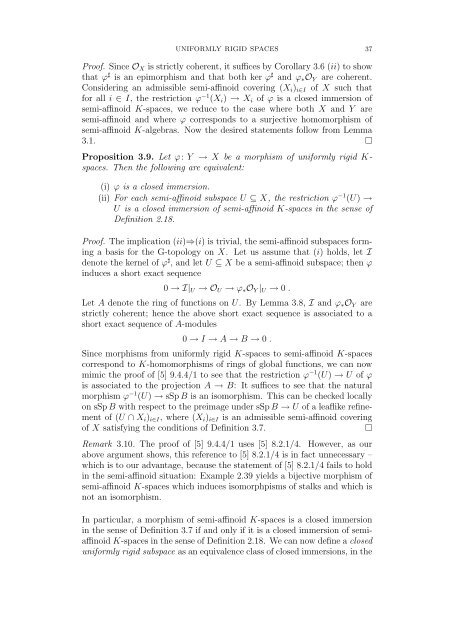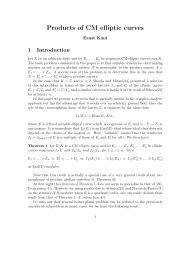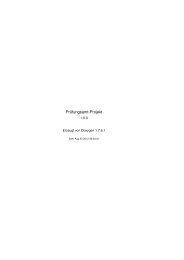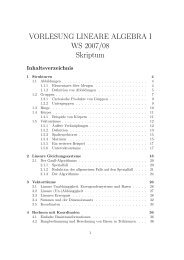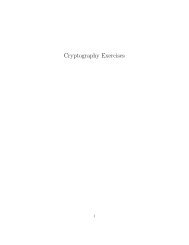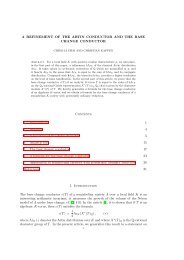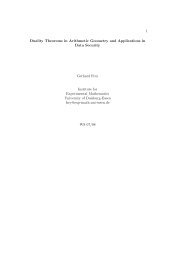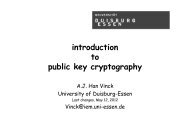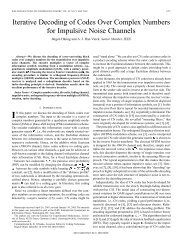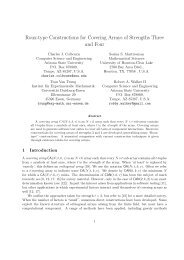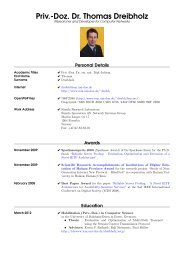UNIFORMLY RIGID SPACES 1. Introduction Let K be a non ...
UNIFORMLY RIGID SPACES 1. Introduction Let K be a non ...
UNIFORMLY RIGID SPACES 1. Introduction Let K be a non ...
Create successful ePaper yourself
Turn your PDF publications into a flip-book with our unique Google optimized e-Paper software.
<strong>UNIFORMLY</strong> <strong>RIGID</strong> <strong>SPACES</strong> 37Proof. Since O X is strictly coherent, it suffices by Corollary 3.6 (ii) to showthat ϕ ♯ is an epimorphism and that both ker ϕ ♯ and ϕ ∗ O Y are coherent.Considering an admissible semi-affinoid covering (X i ) i∈I of X such thatfor all i ∈ I, the restriction ϕ −1 (X i ) → X i of ϕ is a closed immersion ofsemi-affinoid K-spaces, we reduce to the case where both X and Y aresemi-affinoid and where ϕ corresponds to a surjective homomorphism ofsemi-affinoid K-algebras. Now the desired statements follow from Lemma3.<strong>1.</strong> □Proposition 3.9. <strong>Let</strong> ϕ: Y → X <strong>be</strong> a morphism of uniformly rigid K-spaces. Then the following are equivalent:(i) ϕ is a closed immersion.(ii) For each semi-affinoid subspace U ⊆ X, the restriction ϕ −1 (U) →U is a closed immersion of semi-affinoid K-spaces in the sense ofDefinition 2.18.Proof. The implication (ii)⇒(i) is trivial, the semi-affinoid subspaces forminga basis for the G-topology on X. <strong>Let</strong> us assume that (i) holds, let Idenote the kernel of ϕ ♯ , and let U ⊆ X <strong>be</strong> a semi-affinoid subspace; then ϕinduces a short exact sequence0 → I| U → O U → ϕ ∗ O Y | U → 0 .<strong>Let</strong> A denote the ring of functions on U. By Lemma 3.8, I and ϕ ∗ O Y arestrictly coherent; hence the above short exact sequence is associated to ashort exact sequence of A-modules0 → I → A → B → 0 .Since morphisms from uniformly rigid K-spaces to semi-affinoid K-spacescorrespond to K-homomorphisms of rings of global functions, we can nowmimic the proof of [5] 9.4.4/1 to see that the restriction ϕ −1 (U) → U of ϕis associated to the projection A → B: It suffices to see that the naturalmorphism ϕ −1 (U) → sSp B is an isomorphism. This can <strong>be</strong> checked locallyon sSp B with respect to the preimage under sSp B → U of a leaflike refinementof (U ∩ X i ) i∈I , where (X i ) i∈I is an admissible semi-affinoid coveringof X satisfying the conditions of Definition 3.7.□Remark 3.10. The proof of [5] 9.4.4/1 uses [5] 8.2.1/4. However, as ourabove argument shows, this reference to [5] 8.2.1/4 is in fact unnecessary –which is to our advantage, <strong>be</strong>cause the statement of [5] 8.2.1/4 fails to holdin the semi-affinoid situation: Example 2.39 yields a bijective morphism ofsemi-affinoid K-spaces which induces isomorphpisms of stalks and which isnot an isomorphism.In particular, a morphism of semi-affinoid K-spaces is a closed immersionin the sense of Definition 3.7 if and only if it is a closed immersion of semiaffinoidK-spaces in the sense of Definition 2.18. We can now define a closeduniformly rigid subspace as an equivalence class of closed immersions, in the


